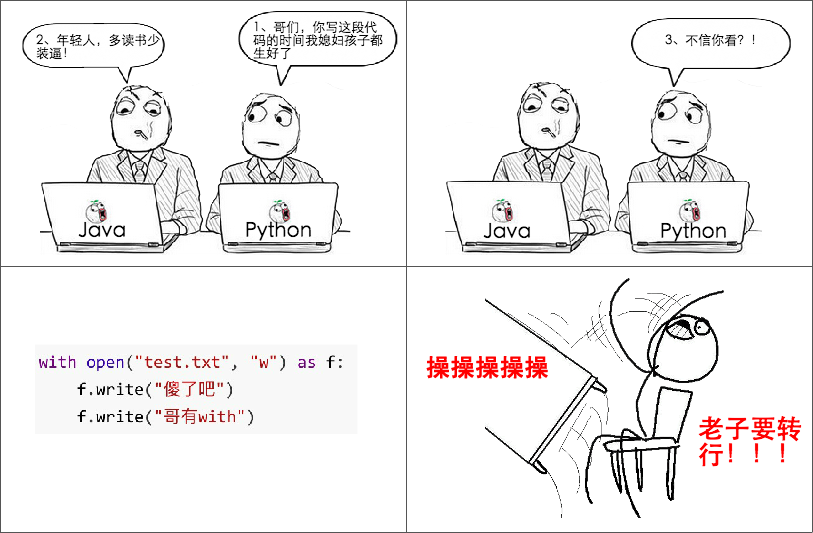眾所周知,所有被打開的系統資源,比如流、文件或者Socket連接等,都需要被開發者手動關閉,否則隨著程序的不斷運行,資源泄露將會累積成重大的生產事故。
在java的江湖中,存在著一種名為finally的功夫,它可以保證當你習武走火入魔之時,還可以做一些自救的操作。在遠古時代,處理資源關閉的代碼通常寫在finally塊中。然而,如果你同時打開了多個資源,那么將會出現噩夢般的場景:
public class Demo { public static void main(String[] args) { BufferedInputStream bin = null; BufferedOutputStream bout = null; try { bin = new BufferedInputStream(new FileInputStream(new File("test.txt"))); bout = new BufferedOutputStream(new FileOutputStream(new File("out.txt"))); int b; while ((b = bin.read()) != -1) { bout.write(b); } } catch (IOException e) { e.PRintStackTrace(); } finally { if (bin != null) { try { bin.close(); } catch (IOException e) { e.printStackTrace(); } finally { if (bout != null) { try { bout.close(); } catch (IOException e) { e.printStackTrace(); } } } } } }}Oh My God!!!關閉資源的代碼竟然比業務代碼還要多!!!這是因為,我們不僅需要關閉BufferedInputStream,還需要保證如果關閉BufferedInputStream時出現了異常, BufferedOutputStream也要能被正確地關閉。所以我們不得不借助finally中嵌套finally大法。可以想到,打開的資源越多,finally中嵌套的將會越深!!!
更為可惡的是,Python程序員面對這個問題,竟然微微一笑很傾城地說:“這個我們一點都不用考慮的嘞~”:

但是兄弟莫慌!我們可以利用Java 1.7中新增的try-with-resource語法糖來打開資源,而無需碼農們自己書寫資源來關閉代碼。媽媽再也不用擔心我把手寫斷掉了!我們用try-with-resource來改寫剛才的例子:
public class TryWithResource { public static void main(String[] args) { try (BufferedInputStream bin = new BufferedInputStream(new FileInputStream(new File("test.txt"))); BufferedOutputStream bout = new BufferedOutputStream(new FileOutputStream(new File("out.txt")))) { int b; while ((b = bin.read()) != -1) { bout.write(b); } } catch (IOException e) { e.printStackTrace(); } }}是不是很簡單?是不是很刺激?再也不用被Python程序員鄙視了!好了,下面將會詳細講解其實現原理以及內部機制。
動手實踐
為了能夠配合try-with-resource,資源必須實現AutoClosable接口。該接口的實現類需要重寫close方法:
public class Connection implements AutoCloseable { public void sendData() { System.out.println("正在發送數據"); } @Override public void close() throws Exception { System.out.println("正在關閉連接"); }}調用類:
public class TryWithResource { public static void main(String[] args) { try (Connection conn = new Connection()) { conn.sendData(); } catch (Exception e) { e.printStackTrace(); } }}運行后輸出結果:
正在發送數據正在關閉連接通過結果我們可以看到,close方法被自動調用了。
原理
那么這個是怎么做到的呢?我相信聰明的你們一定已經猜到了,其實,這一切都是編譯器大神搞的鬼。我們反編譯剛才例子的class文件:
public class TryWithResource { public TryWithResource() { } public static void main(String[] args) { try { Connection e = new Connection(); Throwable var2 = null; try { e.sendData(); } catch (Throwable var12) { var2 = var12; throw var12; } finally { if(e != null) { if(var2 != null) { try { e.close(); } catch (Throwable var11) { var2.addSuppressed(var11); } } else { e.close(); } } } } catch (Exception var14) { var14.printStackTrace(); } }}看到沒,在第15~27行,編譯器自動幫我們生成了finally塊,并且在里面調用了資源的close方法,所以例子中的close方法會在運行的時候被執行。
異常屏蔽
我相信,細心的你們肯定又發現了,剛才反編譯的代碼(第21行)比遠古時代寫的代碼多了一個addSuppressed。為了了解這段代碼的用意,我們稍微修改一下剛才的例子:我們將剛才的代碼改回遠古時代手動關閉異常的方式,并且在sendData和close方法中拋出異常:
public class Connection implements AutoCloseable { public void sendData() throws Exception { throw new Exception("send data"); } @Override public void close() throws Exception { throw new MyException("close"); }}修改main方法:
public class TryWithResource { public static void main(String[] args) { try { test(); } catch (Exception e) { e.printStackTrace(); } } private static void test() throws Exception { Connection conn = null; try { conn = new Connection(); conn.sendData(); } finally { if (conn != null) { conn.close(); } } }}運行之后我們發現:
basic.exception.MyException: close at basic.exception.Connection.close(Connection.java:10) at basic.exception.TryWithResource.test(TryWithResource.java:82) at basic.exception.TryWithResource.main(TryWithResource.java:7) ......好的,問題來了,由于我們一次只能拋出一個異常,所以在最上層看到的是最后一個拋出的異常——也就是close方法拋出的MyException,而sendData拋出的Exception被忽略了。這就是所謂的異常屏蔽。由于異常信息的丟失,異常屏蔽可能會導致某些bug變得極其難以發現,程序員們不得不加班加點地找bug,如此毒瘤,怎能不除!幸好,為了解決這個問題,從Java 1.7開始,大佬們為Throwable類新增了addSuppressed方法,支持將一個異常附加到另一個異常身上,從而避免異常屏蔽。那么被屏蔽的異常信息會通過怎樣的格式輸出呢?我們再運行一遍剛才用try-with-resource包裹的main方法:
java.lang.Exception: send data at basic.exception.Connection.sendData(Connection.java:5) at basic.exception.TryWithResource.main(TryWithResource.java:14) ...... Suppressed: basic.exception.MyException: close at basic.exception.Connection.close(Connection.java:10) at basic.exception.TryWithResource.main(TryWithResource.java:15) ... 5 more可以看到,異常信息中多了一個Suppressed的提示,告訴我們這個異常其實由兩個異常組成,MyException是被Suppressed的異常。可喜可賀!
一個小問題
在使用try-with-resource的過程中,一定需要了解資源的close方法內部的實現邏輯。否則還是可能會導致資源泄露。
舉個例子,在Java BIO中采用了大量的裝飾器模式。當調用裝飾器的close方法時,本質上是調用了裝飾器內部包裹的流的close方法。比如:
public class TryWithResource { public static void main(String[] args) { try (FileInputStream fin = new FileInputStream(new File("input.txt")); GZipOutputStream out = new GZIPOutputStream(new FileOutputStream(new File("out.txt")))) { byte[] buffer = new byte[4096]; int read; while ((read = fin.read(buffer)) != -1) { out.write(buffer, 0, read); } } catch (IOException e) { e.printStackTrace(); } }}在上述代碼中,我們從FileInputStream中讀取字節,并且寫入到GZIPOutputStream中。GZIPOutputStream實際上是FileOutputStream的裝飾器。由于try-with-resource的特性,實際編譯之后的代碼會在后面帶上finally代碼塊,并且在里面調用fin.close()方法和out.close()方法。我們再來看GZIPOutputStream類的close方法:
public void close() throws IOException { if (!closed) { finish(); if (usesDefaultDeflater) def.end(); out.close(); closed = true; }}我們可以看到,out變量實際上代表的是被裝飾的FileOutputStream類。在調用out變量的close方法之前,GZIPOutputStream還做了finish操作,該操作還會繼續往FileOutputStream中寫壓縮信息,此時如果出現異常,則會out.close()方法被略過,然而這個才是最底層的資源關閉方法。正確的做法是應該在try-with-resource中單獨聲明最底層的資源,保證對應的close方法一定能夠被調用。在剛才的例子中,我們需要單獨聲明每個FileInputStream以及FileOutputStream:
public class TryWithResource { public static void main(String[] args) { try (FileInputStream fin = new FileInputStream(new File("input.txt")); FileOutputStream fout = new FileOutputStream(new File("out.txt")); GZIPOutputStream out = new GZIPOutputStream(fout)) { byte[] buffer = new byte[4096]; int read; while ((read = fin.read(buffer)) != -1) { out.write(buffer, 0, read); } } catch (IOException e) { e.printStackTrace(); } }}由于編譯器會自動生成fout.close()的代碼,這樣肯定能夠保證真正的流被關閉。
總結
怎么樣,是不是很簡單呢,如果學會了話

新聞熱點
疑難解答